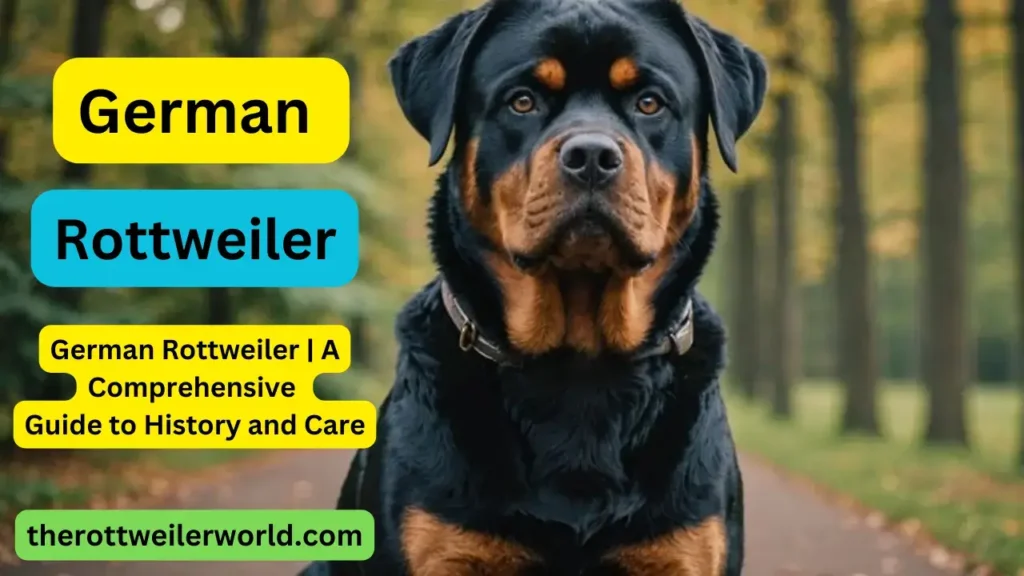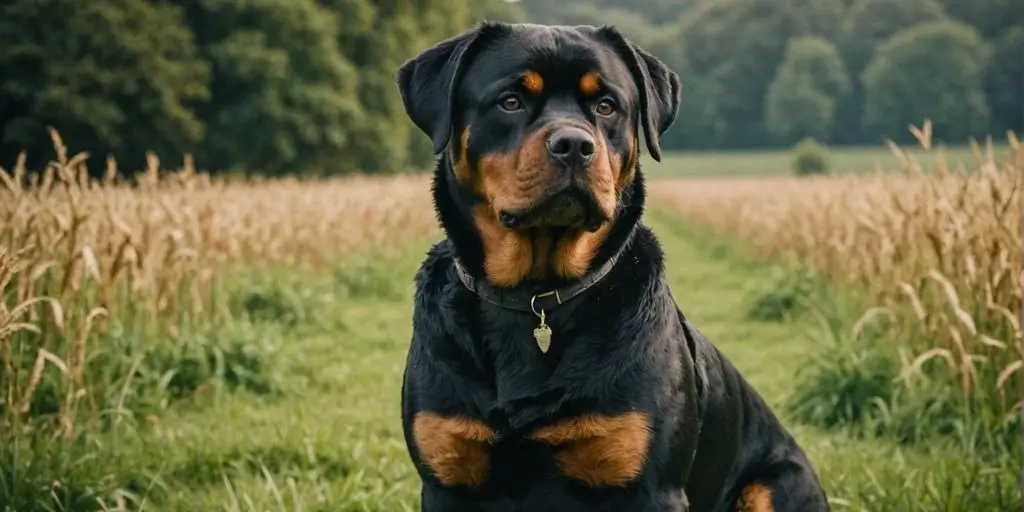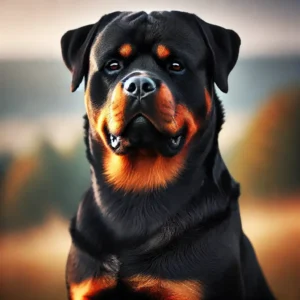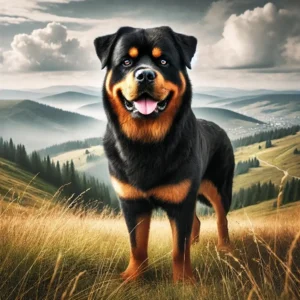The German Rottweiler may be a well-loved canine breed known for its quality, dependability, and defensive nature. Initially from Germany, these mutts have become prevalent around the world for their amazing characteristics and flexibility. They are not fairly awesome protective pooches but too superb companions for families. This article investigates the history, characteristics, and appropriateness of the German Rottweiler as a pet.
Key Takeaways
- German Rottweilers are known for their quality, dependability, and defensive instinct.
- They have a double-coated, brief, and thick hide that’s ordinarily dark with tan or mahogany markings.
- A German Rottweiler that is properly prepared and socialized will typically exhibit good behavior.
- These dogs typically live for 8 to 10 years, and they require customary workouts and mental stimulation.
- German Rottweilers are reasonable for families and can get beside children and other pets when raised together.
History and Beginning
Early Parts and Obligations
The Rottweiler is considered one of the most seasoned surviving canine breeds, with its roots dating back to Roman times. These puppies were at first utilized as herders or driving pooches. They walked over the Alps with the Roman armies, securing people and driving their cattle. Within the locale of Rottweil, these dogs met and mixed with the local mutts in a normal crossing.
Advancement in Germany
In Germany, the breed proceeded to be created, especially within the town of Rottweil, from which it gets its title. The formal history of the breed dates back to 1901 when the primary standard Rottweiler was created by the Worldwide Club for Leonbergers and Rottweilers. This standard made a difference to cement the breed’s characteristics and guarantee its consistency.
Acknowledgment by Pet Hotel Clubs
The Rottweiler picked up acknowledgment from different pet hotel clubs over time. The American Kennel Club (AKC) confirmed the breed’s status in the year 1931. Nowadays, it is recognized by all major pet hotel clubs around the world, guaranteeing its status as a well-established and regarded breed.
Physical Characteristics: German Rottweiler

Estimate and Weight
German Rottweilers are known for their forceful estimate. Guys regularly weigh between 95 to 135 pounds, whereas females weigh from 80 to 100 pounds. Their stature at the bear ordinarily falls between 24 to 27 inches for guys and 22 to 25 inches for females.
Coat and Color
The coat of a German Rottweiler is brief, thick, and straight. It lies level against the body, giving a smooth appearance. It is predominantly dark, with well-defined rust markings on the cheeks, gags, chest, and legs.
Unmistakable Highlights
German Rottweilers have a few unmistakable highlights that set them apart. They have a solid, marginally curved neck that’s well-muscled and free from over-the-top dewlap. The straightness, solidity, and firmness of their backs contrast with their broad and deep chests, contributing approximately 50% to their impressive height. Recounted proof recommends that German Rottweilers are unmistakable in a few physical characteristics, such as having blockier heads and bulkier, more forceful bodies.
Disposition and Identity
Guarding Instinctual
The German Rottweiler is known for its gallant and faithful nature. These mutts are characteristic defenders and will furiously watch their families from any seen risk. Their certainty and sharpness make them amazing watch pooches.
Interaction with Family
German Rottweilers are calm and have a sharp intellect, making them awesome companions. They are superb companions for kids and can be exceptionally tender. If they are raised and socialized appropriately from a youthful age, they will acknowledge other house pets.
Socialization with Other Pets
Early socialization is key for German Rottweilers. When presented to other pets at a youthful age, they can coexist gently. In any case, their guarding instinct is cruel; they may be attentive to new creatures.
Training and Workout
Preparing Strategies
Caring for a Rottweiler breed from Germany entails steadfastness and patience. Positive fortification strategies, such as treats and laud, work best. Begin with basic commands like sit, stay, and come. Enlisting in acquiescence classes can also be useful. Socialization is significant; uncover your Rottweiler to diverse situations, individuals, and other animals early on.
Work out Prerequisites
Shockingly, Rottweilers require less workout than you think. Their vitality levels are generally direct, so 40 minutes of strolling a day is sufficient to fulfill their needs. In any case, they do appreciate more overwhelming exercises like running or playing. Standard workouts make a difference in keeping up with their physical well-being and avoiding behavioral issues.
Mental Incitement
Mental incitement is as critical as a physical workout for German Rottweilers. Perplexed toys sharpen their minds through preparing diversions and deftness courses. Canine sports like submission trials and scent work offer mental rewards in addition to securing a spot.
Health and Lifespan
Common Health Issues in German Rottweiler
German Rottweilers, despite their intense appearance, are inclined to a few well-being issues. These incorporate hip and elbow dysplasia, parvovirus, von Willebrand’s disorder, hypothyroidism, eye disarrangement, and cancer. Many of these issues are innate, so it’s pivotal to induce your Rottweiler from a legitimate breeder.
Preventative Care
To safeguard the health of your Rottweiler, regular vet appointments are necessary. A combination of appropriate exercise, a balanced diet, and vaccinations can prevent many health problems. Early detection through routine health screenings boosts the power of treatment.
Life Expectancy
Normally, German Rottweilers live for 9 to 10 a long time, whereas females can live longer. Well-beingWell-being and genetic components impact this distinction. A sound way of life and tireless care can contribute to your Rottweiler’s life span and joy.
Exercising regularly and feeding your Rottweiler a balanced diet is key to helping your Rottweiler live a long life.
Comparison of German Rottweiler with American Rottweiler
Physical Differences
The American Rottweiler is typically portrayed as having a slender and well-defined musculature, boasting a more agile build than the German Rottweiler. They tend to have a smaller nose and are less broad. Tail docking is common in American Rottweilers, whereas it is not allowed in German Rottweilers.
| Features | German Rottweiler | American Rottweiler |
| Build | Broad and robust | Sleek and athletic |
| Nose Size | Larger | Smaller |
| Tail | Natural | Often docked |
Temperamental Differences
Judges and breeders note that American Rottweilers are lighter in frame and more refined, with much less attitude. Indiscriminate breeding in America has affected the breed’s temperament and conformation. German Rottweilers are known for their strong guarding instincts and confident demeanor.
Suitability for Different Owners
American Rottweilers are ideal for those looking for a family protector and companion. They are also appropriate for those who lean toward an incline, leggy puppy with a docked tail. German Rottweilers, with their vigorous development and strong guarding, may be better suited for experienced canine proprietors who can handle their compelling nature.
Rottweiler’s strong build and impressive size might not be suitable for all pet owners, requiring considerable attention and rigorous training.
Ideal Living Conditions for German Rottweiler
German Rottweilers truly require generous living quarters to prosper at home. They are not well-suited for little flats due to their measure and vitality levels. A house with a yard is perfect for these dynamic mutts. They require a secure, fenced region where they can play and work out unreservedly.
Compatibility with Children
German Rottweilers can be extraordinary companions for children on the off chance that they are legitimately prepared and socialized from a youthful age. They are known for their devotion and defensive nature, which can make them great family pets. In any case, it’s critical to oversee intelligence between youthful children and Rottweilers to guarantee security for both.
Compatibility with Other Pets
Proper socialization is essential for German Rottweilers to coexist peacefully with other pets. Early introductions to distinctive creatures can offer assistance in creating great connections with other mutts and, indeed, cats. Be that as it may, their solid guarding instinct may, in some cases, cause issues with new creatures. It’s vital to present them to other pets steadily and under controlled conditions.
Conclusion
In outline, the German Rottweiler could be a noteworthy breed known for its quality, devotion, and insights. Whether as a working puppy or a family pet, they exceed expectations in different parts due to their flexible nature. With appropriate preparation and socialization, these puppies can be tender companions and furious defenders. Their unmistakable characteristics and strong well-being make them a favored choice for numerous pooch significant others. On the off chance that you’re searching for a tried, true, and cherished canine companion, the German Rottweiler is certainly a breed to consider.
Frequently Asked Questions
A German Rottweiler is a Rottweiler who was born in Germany.
Male German Rottweilers typically reach a height of 24 to 27 inches and weigh between 110 to 132 pounds. In comparison, females stand 22 to 25 inches tall and weigh between 77 to 110 pounds.
Hip dysplasia, elbow dysplasia, and heart problems are common health issues in German Rottweilers. Regular veterinary check-ups aid in early detection and effective management.
Yes, German Rottweilers can be great with kids. They have a nurturing attitude and can be excellent companions when adequately socialized as children.
To maintain good health, German Rottweilers need at least two hours of exercise daily, including walks, playtime, and mentally stimulating activities.
American Rottweilers are generally less solidly built and robust than German Rottweilers. They are recognized for their impressive size and are greatly admired for their strength, devotion, and exceptional working abilities.











